|
From Electrolux to Target
The Origin of Industrial
Design
by Bob Brooke
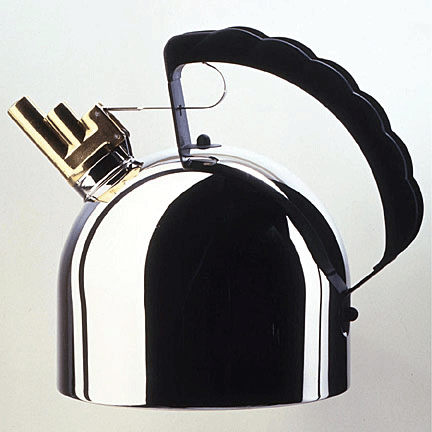 Crafts
people decide on the form and details of whatever they’re creating while
they’re creating it, unlike industrial design where the creative
decisions about a product precedes manufacture, usually involving mass
production. Crafts
people decide on the form and details of whatever they’re creating while
they’re creating it, unlike industrial design where the creative
decisions about a product precedes manufacture, usually involving mass
production.
Industrial design most often focuses on a combination of aesthetics and
user-focused considerations, but also often provides solutions for
problems of form, function, physical ergonomics, marketing, brand
development, sustainability, and sales.
Birth of Industrial Design
The origin of industrial design is directly related to the growth of
industrialization and mechanization that began with the industrial
revolution in Great Britain in the mid 18th century. The rise of
industrial manufacture changed the way objects were made, urbanization
changed patterns of consumption, the growth of empires broadened tastes
and diversified markets, and the emergence of a wider middle class
created demand for fashionable styles.
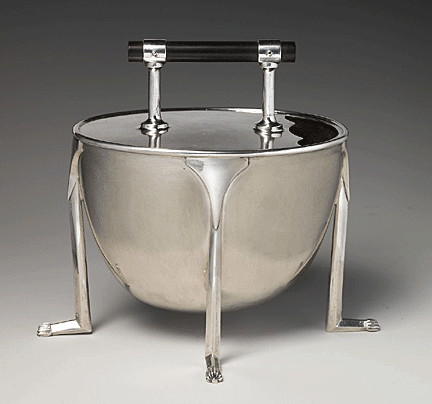 Joseph
Claude Sinel supposedly coined the term "industrial design" in 1919, but
the practice of it had been going on for at least 10 years prior.
Christopher Dresser is considered among the first independent industrial
designers. Although the process of design may be considered creative,
many analytical processes also take place. Joseph
Claude Sinel supposedly coined the term "industrial design" in 1919, but
the practice of it had been going on for at least 10 years prior.
Christopher Dresser is considered among the first independent industrial
designers. Although the process of design may be considered creative,
many analytical processes also take place.
Industrial designers use research, sketching, comparative product
research, model making, prototyping and testing. They decide on the form
of the object, the location of details with respect to one another,
colors, texture, and the product’s use.
In addition to aesthetics, usability, and ergonomics, industrial design
can also encompass engineering, usefulness, and market placement, as
well as the desire and the emotional attachment of the user.
Top Industrial Designers
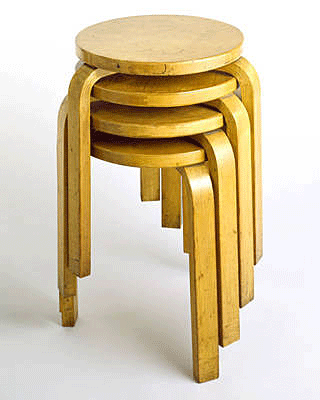 A
number of industrial designers have made such a significant impact on
culture and daily life that their work is documented by historians of
social science. Finnish designer Alvar Aalto, renowned as an architect,
also designed a significant number of household items, such as chairs,
stools, lamps, a tea-cart, and vases. Raymond Loewy was a prolific
American designer who is responsible for the Royal Dutch Shell corporate
logo, the original BP logo (in use until 2000), the PRR S1 steam
locomotive, the Studebaker Starlight (including the later bulletnose),
as well as Schick electric razors, Electrolux refrigerators, short-wave
radios, Le Creuset French ovens, and a complete line of modern
furniture, among many other items. A
number of industrial designers have made such a significant impact on
culture and daily life that their work is documented by historians of
social science. Finnish designer Alvar Aalto, renowned as an architect,
also designed a significant number of household items, such as chairs,
stools, lamps, a tea-cart, and vases. Raymond Loewy was a prolific
American designer who is responsible for the Royal Dutch Shell corporate
logo, the original BP logo (in use until 2000), the PRR S1 steam
locomotive, the Studebaker Starlight (including the later bulletnose),
as well as Schick electric razors, Electrolux refrigerators, short-wave
radios, Le Creuset French ovens, and a complete line of modern
furniture, among many other items.
Dick Teague, who spent most of his career with the American Motors
Corporation, originated the concept of using interchangeable body panels
so as to create a wide array of different vehicles using the same
stampings. He was responsible for such unique automotive designs as the
Pacer, Gremlin, Matador coupe, Jeep Cherokee, and the complete interior
of the Eagle Premier.
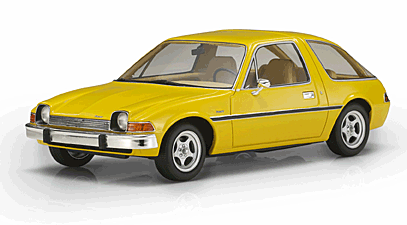
Milwaukee's Brooks Stevens was best known for his Milwaukee Road Skytop
Lounge car and Oscar Mayer Wienermobile designs, among others.
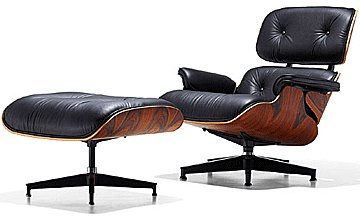 Oskar
Barnack was a German optical engineer, precision mechanic, industrial
designer, and the father of 35mm photography. He developed the Leica,
which became the hallmark for photography for 50 years, and remains a
high-water mark for mechanical and optical design. Oskar
Barnack was a German optical engineer, precision mechanic, industrial
designer, and the father of 35mm photography. He developed the Leica,
which became the hallmark for photography for 50 years, and remains a
high-water mark for mechanical and optical design.
And Charles and Ray Eames were most famous for their pioneering
furniture designs, such as the Eames Lounge Chair Wood and Eames Lounge
Chair. Other influential designers included Henry Dreyfuss, Eliot Noyes,
John Vassos, and Russel Wright.
Making It All Possible
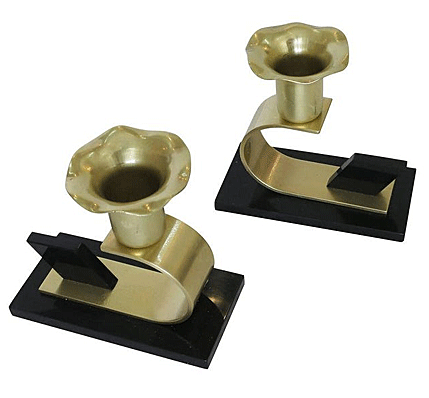 No
company exemplifies the effect of modern industrial design like Chase.
Originally, the company produced brass and copper component parts that
other manufacturers used to make their own products. However, with the
onset of the Great Depression in 1929, many traditional sources of Chase
income collapsed. In its search for new outlets, the company hit upon
the idea of producing its own end product—metal giftware that would be
marketed directly to the consumer. No
company exemplifies the effect of modern industrial design like Chase.
Originally, the company produced brass and copper component parts that
other manufacturers used to make their own products. However, with the
onset of the Great Depression in 1929, many traditional sources of Chase
income collapsed. In its search for new outlets, the company hit upon
the idea of producing its own end product—metal giftware that would be
marketed directly to the consumer.
No manufacturer took the concept of "cheaper and better goods for all
more to heart than the Chase Brass & Copper Company of Waterbury,
Connecticut. Between 1930 and 1942, the Chase Specialty Division offered
nearly 500 different metal giftware selections, each suited to the
particular needs of cash-strapped consumers. Chase buffet service
pieces, smoker's articles, drinking accessories, and decorative items
provided the look of luxury at an economical price.
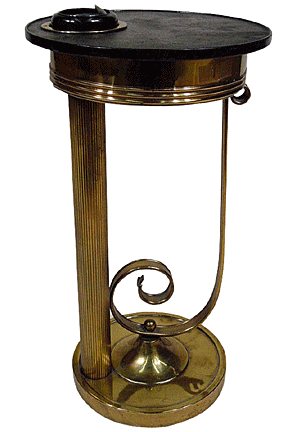 Available
in such attractive finishes as brass, copper and the newly popular
chrome, Chase products were also durable and required little care.
Homemakers accustomed to hours spent polishing tarnished silver were
immediately attracted by ads that promised with Chase there was no
polishing or cleaning to get ready for a party. Chromium kept shining
brilliant and was always ready to use. Available
in such attractive finishes as brass, copper and the newly popular
chrome, Chase products were also durable and required little care.
Homemakers accustomed to hours spent polishing tarnished silver were
immediately attracted by ads that promised with Chase there was no
polishing or cleaning to get ready for a party. Chromium kept shining
brilliant and was always ready to use.
The new Chase Specialty division readily adapted existing equipment and
procedures to giftware production, often making use of in-stock
inventory parts in the process. The key ingredient in the success of
this bold experiment was the industrial designer. This unique figure
first came to prominence in the 1930s.
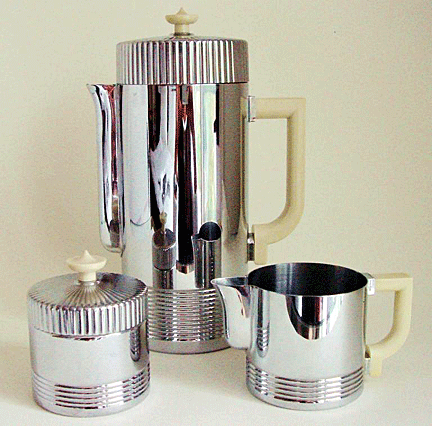 In
essence, industrial design introduced, as Fortune magazine noted in
1934, ºart into industries hitherto artless.' A primary function of the
industrial designer was to rethink the familiar in ways that would prove
popular to buyers. If the usefulness, cost and appearance of an object
as humdrum as a teakettle or serving tray could be improved upon,
consumers would be more likely to invest in it―even if a previous
version was still performing reasonably well. The result, as Modern
Plastics noted in May, 1935, was an influx of the new and improved
products. "Probably at no time since John Alden and Priscilla Mullen
were married and set up house keeping in their log hut in the Plymouth
Colony have pots and pan, and other kitchen and dining room utensils,
been so well designed and so good to look at as they are today." In
essence, industrial design introduced, as Fortune magazine noted in
1934, ºart into industries hitherto artless.' A primary function of the
industrial designer was to rethink the familiar in ways that would prove
popular to buyers. If the usefulness, cost and appearance of an object
as humdrum as a teakettle or serving tray could be improved upon,
consumers would be more likely to invest in it―even if a previous
version was still performing reasonably well. The result, as Modern
Plastics noted in May, 1935, was an influx of the new and improved
products. "Probably at no time since John Alden and Priscilla Mullen
were married and set up house keeping in their log hut in the Plymouth
Colony have pots and pan, and other kitchen and dining room utensils,
been so well designed and so good to look at as they are today."
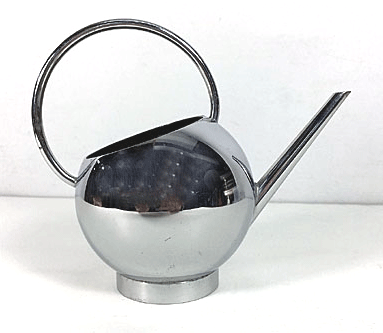 Those
responsible for this onslaught of creativity came from many walks of
life. The prolific Lorene Guild began his career as an illustrator.
Russel Wright designed stage settings. Dr. Albert Reimann made notable
contributions to the Chase decorative line without ever leaving his
native Berlin. Variety in experiences and input meant variety in design—a major factor in the ongoing popularity of Chase giftware. Although
working within the boundaries of the same medium (metal), and the same
product realm (such Chase mainstays as ashtrays, vases and serving
dishes), designers were free to creatively explore the infinite
possibilities contained within those boundaries. The diverse product
inventory that emerged from this experimentation is one that remains
consistently fascinating. Those
responsible for this onslaught of creativity came from many walks of
life. The prolific Lorene Guild began his career as an illustrator.
Russel Wright designed stage settings. Dr. Albert Reimann made notable
contributions to the Chase decorative line without ever leaving his
native Berlin. Variety in experiences and input meant variety in design—a major factor in the ongoing popularity of Chase giftware. Although
working within the boundaries of the same medium (metal), and the same
product realm (such Chase mainstays as ashtrays, vases and serving
dishes), designers were free to creatively explore the infinite
possibilities contained within those boundaries. The diverse product
inventory that emerged from this experimentation is one that remains
consistently fascinating.
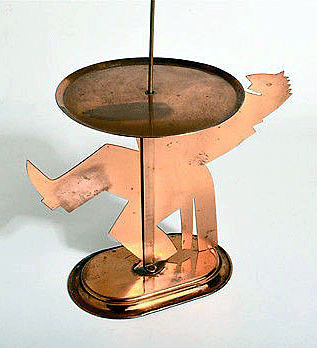 Lurelle
Guild was easily one of the most in-demand industrial designers of the
day. In 1934 alone, he produced designs for nearly 1,000 products. In
addition to his freelance Specialty designs for Chase. Guild also
created an entire line of lamps and lighting fixtures for the Chase
Lighting division. Other Guild clients included Kensington, Westinghouse
and General Electric, and his products ranged from washing machines to
trolley cars. Whimsicality and practicality combine in such Guild
designs for Chase as the "Pretzelman" and the "Colonel's Lady Light.-
Although he told Fortune magazine in 1934 that "beauty alone does not
sell," Guild seemed well aware that it remained an important sales
component. Lurelle
Guild was easily one of the most in-demand industrial designers of the
day. In 1934 alone, he produced designs for nearly 1,000 products. In
addition to his freelance Specialty designs for Chase. Guild also
created an entire line of lamps and lighting fixtures for the Chase
Lighting division. Other Guild clients included Kensington, Westinghouse
and General Electric, and his products ranged from washing machines to
trolley cars. Whimsicality and practicality combine in such Guild
designs for Chase as the "Pretzelman" and the "Colonel's Lady Light.-
Although he told Fortune magazine in 1934 that "beauty alone does not
sell," Guild seemed well aware that it remained an important sales
component.
Harry Laylon's designs were literally the backbone of the Chase
Specialty line. From his arrival at Chase in 1933 until his departure in
1940, Laylon created more giftware designs than any other Chase
designer. He also served as the company's director of design from 1937
onward and designed "The Chase Shops," retail outlet displays for Chase
products. From plant stands to sugar and creamers to candle snuffers,
Laylon proved adept at designing for every Chase giftware category.
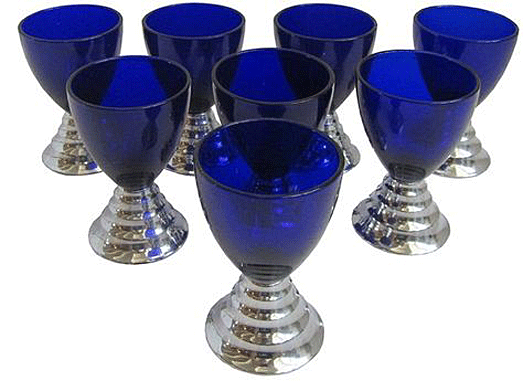
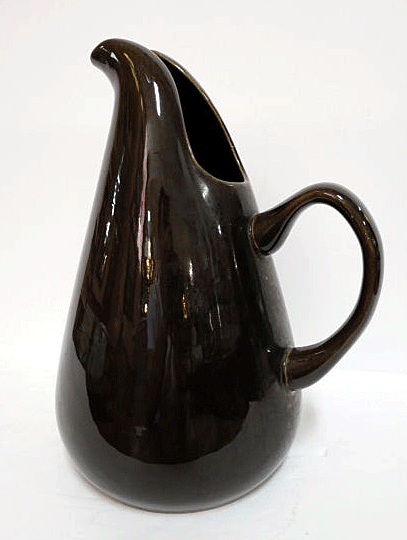 Russel
Wright is perhaps best known for his line of "American Modern"
dinnerware, designed several years after his free-lance assignments for
Chase. Wright's early work in pewter and aluminum led to a Chase
contract in 1933. His successes there include such favorites as the
Pancake and Corn Set" and the "Liqueur Set." Both of these make use of a
unique "Coaster Tray" of chrome and "English blue(cobalt) ' glass.
Wright, like many of the Chase de signers, was capable of looking at the
established with a fresh eye: the small ' spheres of the ^Pancake and
Corn Set" were originally manufactured as ornamental brass bedstead
balls. Russel
Wright is perhaps best known for his line of "American Modern"
dinnerware, designed several years after his free-lance assignments for
Chase. Wright's early work in pewter and aluminum led to a Chase
contract in 1933. His successes there include such favorites as the
Pancake and Corn Set" and the "Liqueur Set." Both of these make use of a
unique "Coaster Tray" of chrome and "English blue(cobalt) ' glass.
Wright, like many of the Chase de signers, was capable of looking at the
established with a fresh eye: the small ' spheres of the ^Pancake and
Corn Set" were originally manufactured as ornamental brass bedstead
balls.
In 1936, Walter Von Hessen commented to House Beautiful that "a designer
today must be an inventor, too." The designing minds of Chase were all
of that, and more, Innovators as well as adapters, they took the best of
the past and made it better.
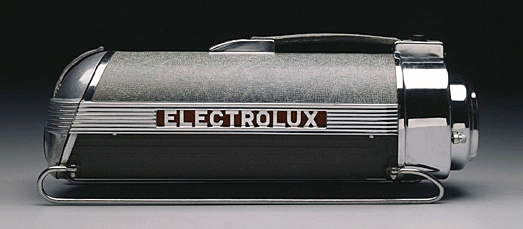
Today, industrial designers are busy designing everything for the home
and office from cookware to furniture to electronic devices—but the real
push for industrial design began in the 1930s and has soared ever higher
since. Consumers can now find well designed products at retail stores
like Target.
<
More Special Features
Next Article > |
